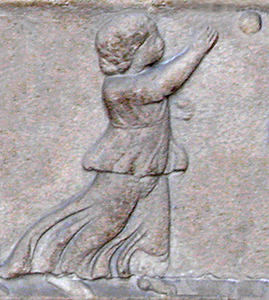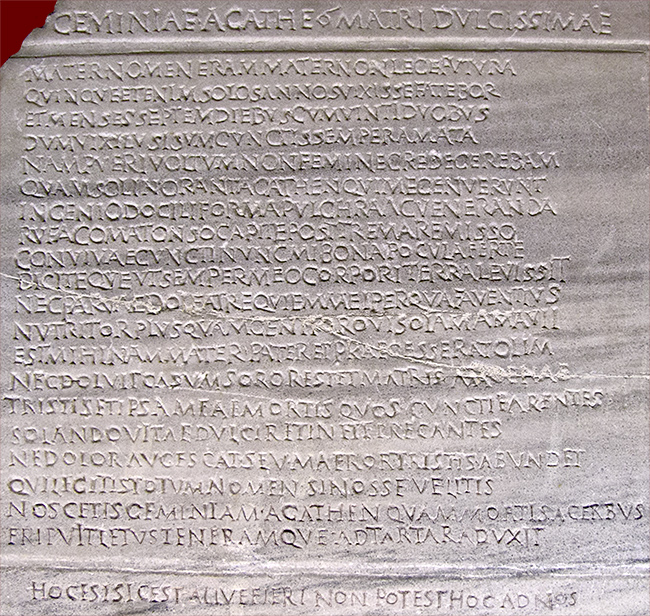
detail, Roman sarcophagus, 2nd century CE

Geminia Agathe died at the age of five in the city of Rome some time in the second century CE, her passing commemorated by a marble funerary tablet with two carved wings (tabula ansata), each containing a letter (D and M). The tablet is rather plain, with a lengthy inscription in the center carved in cramped, uneven letters, but the content of the inscription is remarkable. Someone felt that this little girl deserved more than a conventional epitaph and laboriously composed a twenty-line poem in dactylic hexameter. Unlike the poem on the altar of three-year-old Aelia Sabina, where the poetic diction and mythological allusions suggest a hired versifier, Geminia Agathe's poem was a labor of love rather than skill. The meter is heavily spondaic, and eight lines (3, 5, 8, 10, 11, 15, 19, 20) will scan only with incorrect vowel quantities and/or contracted syllables. But the poem paints a vivid picture of a lively little tomboy, easily mistaken for a boy, who loved her life of games and sports. Except for a single mention of beauty (forma pulchra), this inscription avoids the gender-specific feminine qualities emphasized in most epitaphs for females, even female children. The poem is written in the voice of Agathe, and its entire focus is on her, with others described from her perspective. She is even presented as the bringer of solace to her family, asking them to remember the happiness of her life instead of grieving too much. Who was this unusual little girl? The introductory dedication calls her Geminia Agathe Mater, though Mater was obviously a nickname, as line 19 indicates. The inscription contains none of the usual indications of status for herself or her family, but we can make some educated deductions based on the names (see names of freedpeople). The gens Geminia is well-attested in Rome, but her Greek cognomen, Agathe, would not typically be used in a free citizen family of any status. Because of her young age, she was probably freeborn but into a family of freedpersons who were not necessarily citizens. Her mother's name, Amoena, suggests that she was likely a freedwoman, though the inscription does not give her nomen, and Agathe's deceased father is not named at all. Agathe lived with her mother and her mother's unnamed sister, probably also a freedwoman, and a man named Faventius, a cognomen attested for slaves and freedpersons. Faventius may have been a freedman married to Agathe's mother, but it would seem very odd to call a stepfather nutritor, the term used for a male child-minder, corresponding to the female nutrix. More likely, he was a slave or freedman in the familia assigned to take care of little Agathe, perhaps the only servant they had, thus accounting for the fact that a female child had a male caregiver. It is even possible that he composed the poem, since he is mentioned before Agathe's mother, father, and aunt, and since his love for his little charge is so strongly stressed. Whoever the author was, he or she has succeeded in making Geminia Agathe unforgettable.

GEMINIAE
AGATHE  MATRI DVLCISSIMAE
MATRI DVLCISSIMAE
1 MATER NOMEN, ERAM MATER NON LEGE FVTVRA,
QVINQVE ETENIM SOLOS ANNOS VIXISSE FATEBOR
ET MENSES SEPTEM DIEBVS CVM VINTI DVOBVS.
DVM VIXI,
LVSI; SVM
CVNCTIS SEMPER AMATA.
![]()
5
NAM PVERI
VOLTVM, NON
FEMINE,
CREDE,
GEREBAM,
![]()
QVAM SOLI NORANT AGATHEN QVI ME GENVERVNT,
INGENIO DOCILI, FORMA PVLCHRA AC VENERANDA,
RVFA
COMA,
TONSO
CAPITE
POSTTREMA
REMISSO.
![]()
CONVIVAE CVNCTI NVNC
MI BONA
POCVLA
FERTE
![]()
10DICITEQVE VT SEMPER MEO
CORPORI TERRA
LEVIS
SIT.
![]()
NEC PARVAE DOLEAT REQVIEM MEI PERQVA FAVENTIVS,
NVTRITOR PLVS QVAM GENITOR, OVI SOLAM AMAVII.
EST MIHI NAM MATER; PATER ET PRAECESSERAT OLIM
NEC DOLVIT CASVM. SOROR EST ET MATRIS AMOENAE
15TRISTIS ET IPSA MEAE MORTIS. QVOS CVNCTI PARENTES
SOLANDO VITAE DVLCI RETINETE PRECANTES
NE
DOLOR
AVGESCAT
SEV
MAEROR TRISTIS
ABVNDET.
![]()
QVI LEGITIS, TOTVM NOMEN SI NOSSE VELITIS,
NOSCETIS GEMINIAM AGATHEN, QVAM MORTIS ACERBVS
20ERIPVIT
LETVS
TENERAMQVE AD
TARTARA DVXIT.
![]()
![]()
Click on the underlined words for translation aids and commentary, which will appear in a small window. Click on the icon link
![]() to the right of the text for related images and information.
to the right of the text for related images and information.